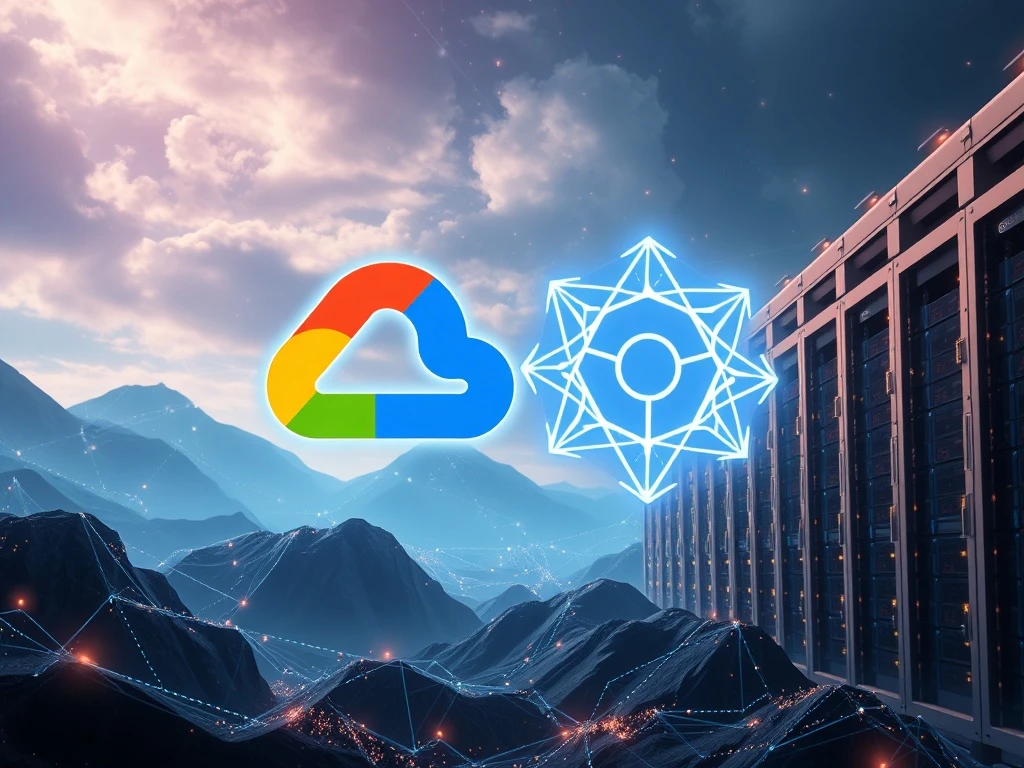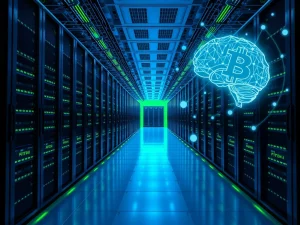Google Cloud’s Astonishing 32% Q2 Revenue Leap: Fueling the OpenAI Partnership and AI Infrastructure Boom

In the rapidly evolving digital landscape, the underlying infrastructure powering our most advanced technologies is more critical than ever. For those deeply entrenched in the cryptocurrency world, understanding the backbone of innovation – from blockchain networks to sophisticated trading algorithms – often leads back to robust cloud computing. This is precisely why the recent news surrounding Google Cloud‘s remarkable financial performance, driven by a groundbreaking OpenAI partnership, sends ripples across the entire tech ecosystem, including the crypto space. Just as decentralized networks demand powerful computational resources, the surging demand for artificial intelligence is reshaping how tech giants collaborate and compete for dominance in the AI infrastructure arena.
Google Cloud’s Stunning Q2 Revenue Surge: A Testament to AI’s Power
Google Cloud isn’t just growing; it’s accelerating. The tech giant’s cloud division reported a colossal 32.0% surge in its Q2 revenue for 2025, reaching an impressive $13.6 billion. This marks a significant jump from $10.3 billion in the same period the previous year, underscoring the escalating demand for cloud services, particularly those optimized for artificial intelligence. CEO Sundar Pichai highlighted this growth during Google’s Q2 2025 earnings call, emphasizing the strategic importance of AI-focused offerings in driving this impressive financial trajectory.
What’s fueling this phenomenal growth? A significant part of the answer lies in strategic alliances, even with erstwhile rivals. The partnership with OpenAI, a company often seen as a direct competitor to Google’s own AI ambitions, stands out as a pivotal move. This collaboration positions Google Cloud as a critical supplier for OpenAI’s insatiable computational needs, a testament to the growing necessity for diversified cloud infrastructure in the fast-paced world of AI development.
The OpenAI Partnership: A Strategic Alliance in the AI Arms Race?
The decision by OpenAI, famously backed by Microsoft’s Azure, to also tap into Google’s vast resources — including high-demand Nvidia GPUs and Google’s proprietary Tensor Processing Units (TPUs) — highlights a fascinating dynamic in the AI landscape. It’s a blend of fierce competition and pragmatic collaboration, driven by the sheer scale and complexity of training cutting-edge generative AI models like ChatGPT.
This isn’t merely a transactional deal; it’s a strategic maneuver reflecting several key trends:
- Resource Scarcity: Advanced computing hardware, especially top-tier GPUs, is a finite and highly sought-after commodity. Diversifying cloud providers helps mitigate supply chain risks and ensures continuous access to the computational horsepower required for intensive AI model training.
- Cost Escalation: The financial outlay for developing and training large AI models is astronomical. Leveraging multiple cloud providers can offer cost efficiencies, flexibility, and access to specialized hardware or pricing models.
- Accelerated R&D: By pooling resources and expertise, companies can potentially accelerate their research and development timelines, bringing new AI innovations to market faster.
While the OpenAI partnership secures Google Cloud a lucrative position in the AI infrastructure market, it also presents an intriguing paradox. OpenAI’s success, particularly with its large language models, poses a potential long-term threat to Google’s core search business. Yet, by hosting OpenAI, Google Cloud reinforces its position as a key player in the multi-billion-dollar market segment. This dual strategy – investing billions in developing in-house AI models like Gemini while simultaneously powering rivals – highlights the delicate balance between innovation and commercial pragmatism in the tech industry.
The AI Infrastructure Gold Rush: Why Diversification is Key
The broader industry dynamics further illuminate OpenAI’s decision to diversify its cloud providers, extending even to Oracle. This move underscores the critical need for scalable, flexible, and resilient infrastructure to meet AI’s insatiable demand for computational power. Analysts widely acknowledge that such partnerships are crucial for mitigating supply chain risks and accelerating R&D timelines, enabling companies to pool resources and expertise to overcome technological bottlenecks.
For Google, this means leveraging its extensive hardware inventory and deep cloud expertise to capture significant market share. Even as it competes fiercely with OpenAI in the consumer AI space, the strategic move to become a foundational provider for its rival’s computational needs ensures a vital revenue stream. This mirrors historical precedents in the tech world, such as Google’s early relationship with Yahoo, where initial collaboration eventually gave way to direct competition. The current landscape suggests that while collaboration is necessary now due to shared needs and scarce resources, the underlying competitive tension remains.
Generative AI: Reshaping the Digital Frontier and Monetization Challenges
The implications of this enhanced AI infrastructure access for the broader AI ecosystem are profound. OpenAI’s ability to tap into Google’s robust infrastructure could significantly accelerate the development of next-generation generative AI models, intensifying the already fierce competition in a sector dominated by giants like Microsoft and Google. For cryptocurrency projects, this could mean faster, more powerful AI tools for market analysis, fraud detection, and even the creation of sophisticated smart contracts or decentralized applications.
Meanwhile, Google’s own formidable AI offerings, such as Gemini and AI Overviews, boast massive user bases (450 million and 2 billion monthly active users, respectively). The challenge for Google, as for many tech companies, lies in effectively monetizing this vast reach. The partnership with OpenAI thus creates a fascinating paradox: Google supports a company that could potentially disrupt its most profitable business while simultaneously securing a vital revenue stream from the burgeoning AI infrastructure boom.
Navigating the Evolving AI Landscape: Consolidation and Hybrid Models
The broader AI market is poised for further consolidation, with major cloud providers like Google Cloud, Azure, and Oracle emerging as the undeniable gatekeepers of critical computational resources. This centralization naturally raises questions about accessibility for smaller players and startups, potentially creating innovation bottlenecks if access to cutting-edge infrastructure becomes too prohibitive. However, this collaboration also demonstrates a significant shift in the industry toward hybrid models, where open platforms and proprietary tools can coexist, driving progress through a blend of shared resources and competitive innovation.
As generative AI continues to reshape industries, from content creation to scientific research and even financial services (including crypto analytics), the ability to scale infrastructure remains a defining factor in determining market leadership. Companies that can efficiently provide or access the necessary computational power will be best positioned to innovate, capture market share, and ultimately define the future of artificial intelligence. This strategic alliance between Google Cloud and OpenAI is not just a business deal; it’s a blueprint for how the titans of tech will navigate the complex, high-stakes world of AI development.
Source: [1] [title1] [url1] [2] [title2] [url2] [3] [title3] [url3]
Frequently Asked Questions (FAQs)
Q1: Why is Google Cloud partnering with OpenAI despite being competitors?
A: This partnership is a strategic move driven by the immense demand for high-end AI infrastructure. While Google and OpenAI compete in the consumer AI space, Google Cloud benefits from a significant revenue stream by providing its powerful cloud resources (including Nvidia GPUs and TPUs) to OpenAI. It’s a pragmatic approach to monetize Google’s infrastructure and leverage its strengths in a rapidly growing market, even if it means supporting a rival’s computational needs.
Q2: How did Google Cloud’s Q2 revenue surge, and what role did AI play?
A: Google Cloud’s Q2 revenue surged by 32.0% to $13.6 billion, a growth trajectory largely attributed to its expanding AI-focused offerings. The increasing adoption of AI across various industries has led to a booming demand for cloud services capable of handling intensive AI model training and deployment. The partnership with OpenAI is a significant contributor to this surge, as OpenAI requires massive computational power.
Q3: What role do Nvidia GPUs and Google’s TPUs play in this OpenAI partnership?
A: Nvidia GPUs (Graphics Processing Units) and Google’s Tensor Processing Units (TPUs) are specialized hardware essential for training and running large AI models like those developed by OpenAI. These units provide the immense parallel processing power required for complex calculations. By accessing Google Cloud’s inventory of these high-demand components, OpenAI can fuel its generative AI models, ensuring they have the necessary resources for development and operation.
Q4: What are the broader implications of this partnership for the AI ecosystem?
A: This partnership has several profound implications. It highlights the scarcity of advanced computing hardware and the escalating costs of AI development, driving competitors to collaborate. It could accelerate the development of next-generation AI models by giving OpenAI access to more diverse and powerful infrastructure. It also signifies a trend towards hybrid models in the AI industry, where resource-sharing coexists with intense competition, and major cloud providers become crucial gatekeepers of AI innovation.
Q5: How does this partnership benefit OpenAI, beyond just access to hardware?
A: Beyond just hardware access, the partnership allows OpenAI to diversify its cloud providers, reducing reliance on a single vendor (like Microsoft Azure). This diversification mitigates supply chain risks, offers greater flexibility in resource allocation, and potentially provides access to different cloud architectures or pricing models. It ensures that OpenAI can scale its operations and continue its rapid R&D without being constrained by the availability of a single cloud provider’s resources.
Q6: Is this trend of competitors collaborating new in the tech industry?
A: While the scale and nature of AI infrastructure needs are unique, the concept of competitors collaborating on foundational technologies is not entirely new in the tech industry. Historical examples, such as Google’s early relationship with Yahoo or various joint ventures in the semiconductor industry, show that companies sometimes collaborate to develop or share essential resources before eventually intensifying their competition in end-user markets. This Google Cloud-OpenAI partnership is a modern iteration of this strategic dynamic, driven by the unique demands of the AI era.









